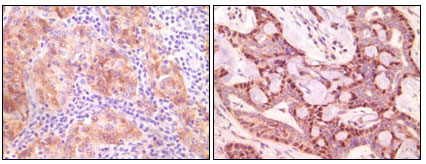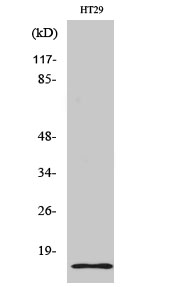Synuclein-γ Monoclonal Antibody
- Catalog No.:YM0607
- Applications:WB;IHC;IF;ELISA
- Reactivity:Human
- Target:
- Synuclein-γ
- Gene Name:
- SNCG
- Protein Name:
- Gamma-synuclein
- Human Gene Id:
- 6623
- Human Swiss Prot No:
- O76070
- Mouse Swiss Prot No:
- Q9Z0F7
- Immunogen:
- Purified recombinant fragment of Synuclein-γ expressed in E. Coli.
- Specificity:
- Synuclein-γ Monoclonal Antibody detects endogenous levels of Synuclein-γ protein.
- Formulation:
- Liquid in PBS containing 50% glycerol, 0.5% BSA and 0.02% sodium azide.
- Source:
- Monoclonal, Mouse
- Dilution:
- WB 1:500 - 1:2000. IHC 1:200 - 1:1000. ELISA: 1:10000.. IF 1:50-200
- Purification:
- Affinity purification
- Concentration:
- 1 mg/ml
- Storage Stability:
- -15°C to -25°C/1 year(Do not lower than -25°C)
- Other Name:
- SNCG;BCSG1;PERSYN;PRSN;Gamma-synuclein;Breast cancer-specific gene 1 protein;Persyn;Synoretin;SR
- Molecular Weight(Da):
- 13kD
- References:
- 1. Haiyan Liu, Wei Liu, Yinwei Wu. Cancer Res. 2005 Sep 1;65(17):7635-43.
2. Irina Surgucheva , Belinda McMahon , Andrei Surguchov. Cell Motil Cytoskeleton. 2006 May 26.
- Background:
- This gene encodes a member of the synuclein family of proteins which are believed to be involved in the pathogenesis of neurodegenerative diseases. Mutations in this gene have also been associated with breast tumor development. [provided by RefSeq, Jan 2010],
- Function:
- disease:Brain iron accumulation type 1 (NBIA1, also called Hallervorden-Spatz syndrome), a rare neuroaxonal dystrophy, is histologically characterized by axonal spheroids, iron deposition, Lewy body (LB)-like intraneuronal inclusions, glial inclusions and neurofibrillary tangles. SNCG is found in spheroids but not in inclusions.,function:Plays a role in neurofilament network integrity. May be involved in modulating axonal architecture during development and in the adult. In vitro, increases the susceptibility of neurofilament-H to calcium-dependent proteases (By similarity). May also function in modulating the keratin network in skin. Activates the MAPK and Elk-1 signal transduction pathway.,PTM:Phosphorylated. Phosphorylation by GRK5 appears to occur on residues distinct from the residue phosphorylated by other kinases.,similarity:Belongs to the synuclein family.,subcellular location:As
- Subcellular Location:
- Cytoplasm, perinuclear region . Cytoplasm, cytoskeleton, microtubule organizing center, centrosome . Cytoplasm, cytoskeleton, spindle . Associated with centrosomes in several interphase cells. In mitotic cells, localized to the poles of the spindle.
- Expression:
- Highly expressed in brain, particularly in the substantia nigra. Also expressed in the corpus callosum, heart, skeletal muscle, ovary, testis, colon and spleen. Weak expression in pancreas, kidney and lung.
- June 19-2018
- WESTERN IMMUNOBLOTTING PROTOCOL
- June 19-2018
- IMMUNOHISTOCHEMISTRY-PARAFFIN PROTOCOL
- June 19-2018
- IMMUNOFLUORESCENCE PROTOCOL
- September 08-2020
- FLOW-CYTOMEYRT-PROTOCOL
- May 20-2022
- Cell-Based ELISA│解您多样本WB检测之困扰
- July 13-2018
- CELL-BASED-ELISA-PROTOCOL-FOR-ACETYL-PROTEIN
- July 13-2018
- CELL-BASED-ELISA-PROTOCOL-FOR-PHOSPHO-PROTEIN
- July 13-2018
- Antibody-FAQs
- Products Images

- Western Blot analysis using Synuclein-γ Monoclonal Antibody against truncated Synuclein-γ recombinant protein.

- Immunohistochemistry analysis of paraffin-embedded human ovary carcinoma (left) and breast carcinoma (right), showing cytoplasmic(ovary carcinoma) localization, cytoplasmic and nuclear (breast carcinoma) localization with DAB staining using Synuclein-γ Mo


